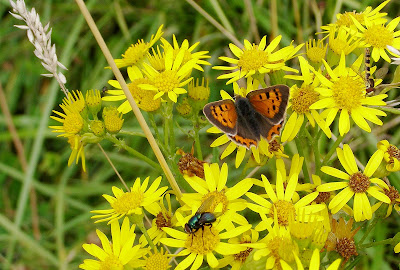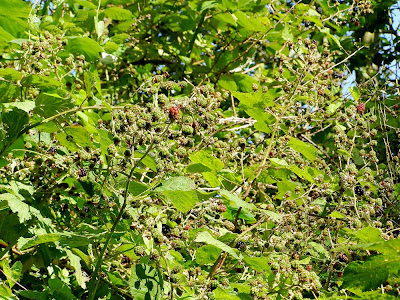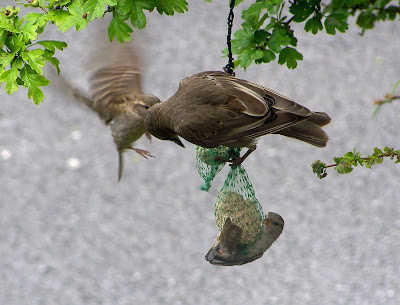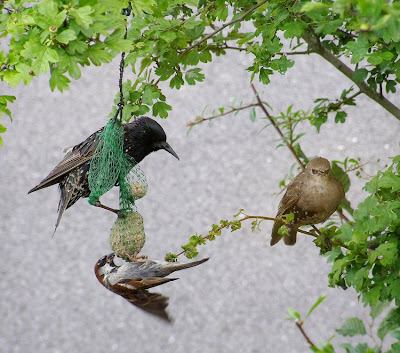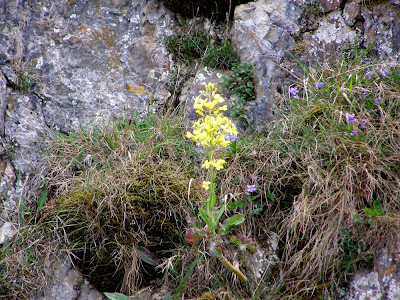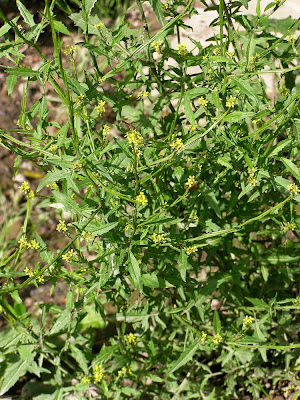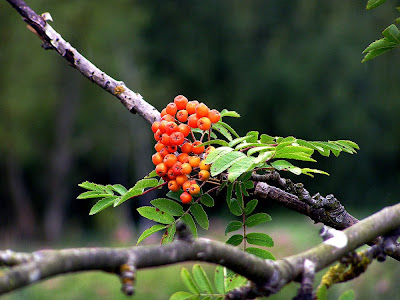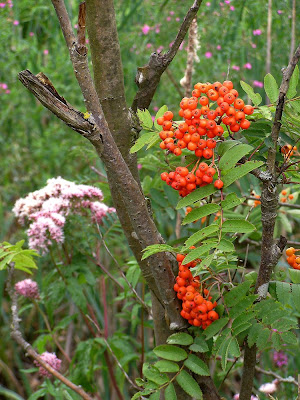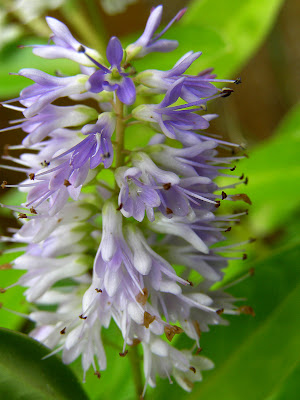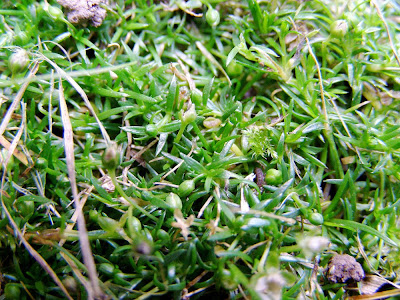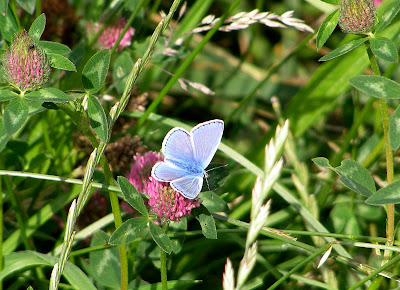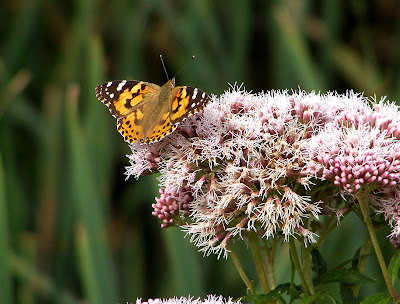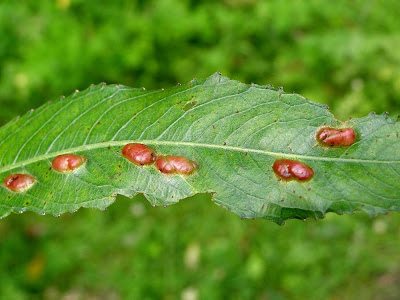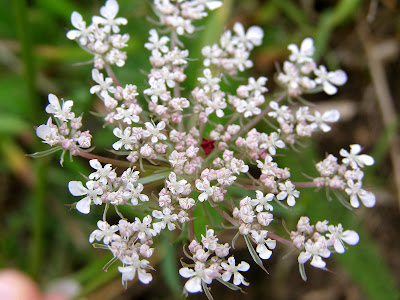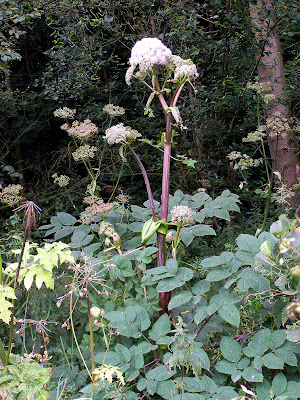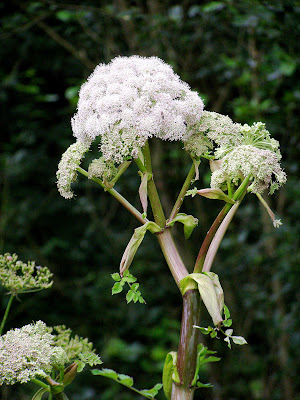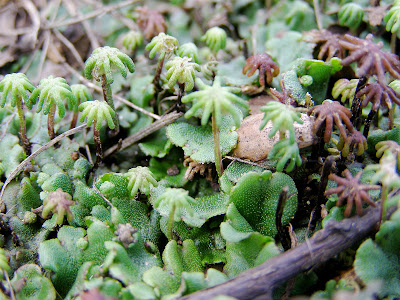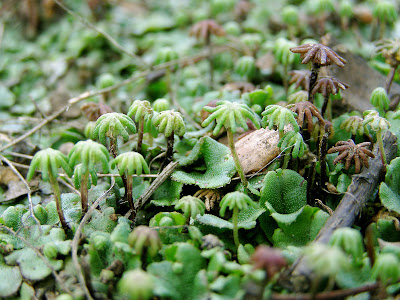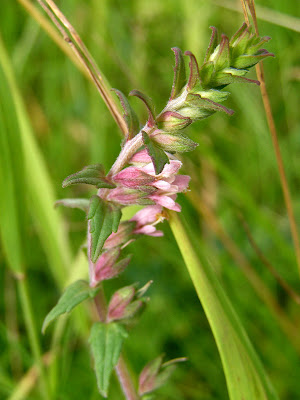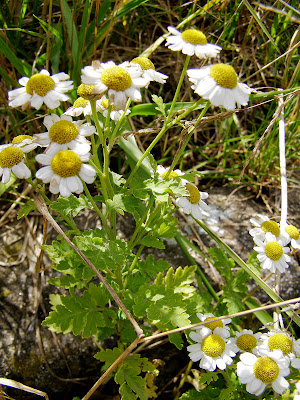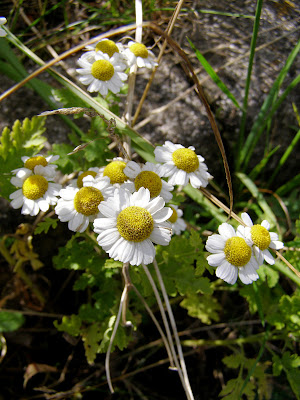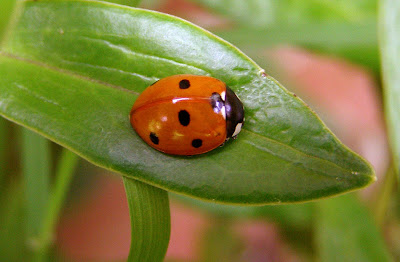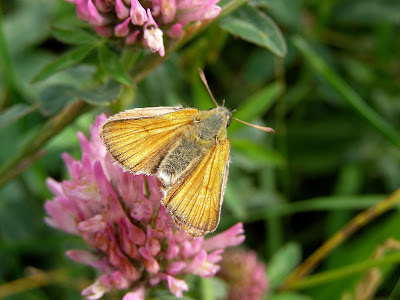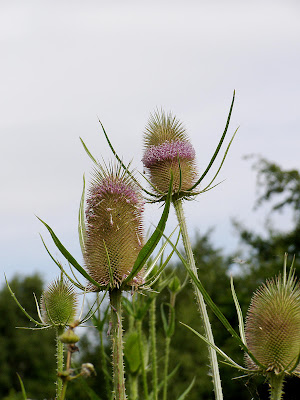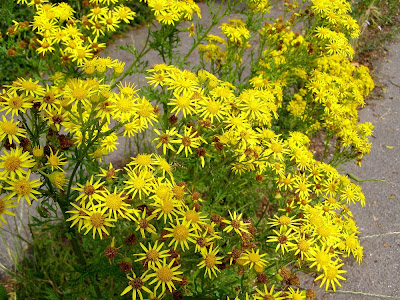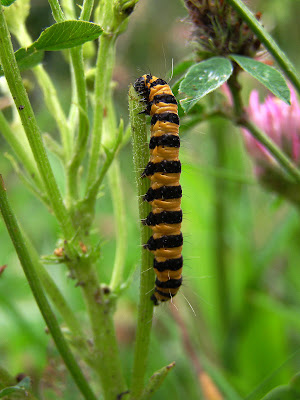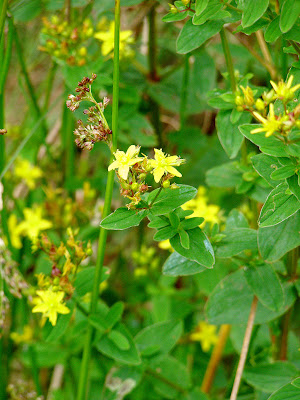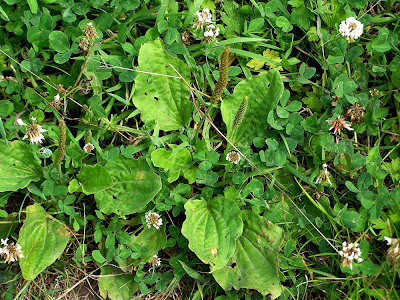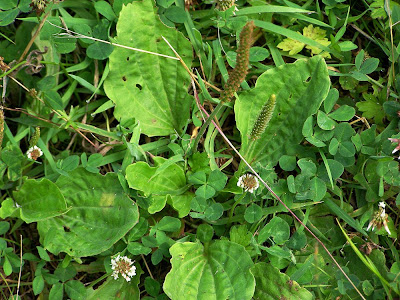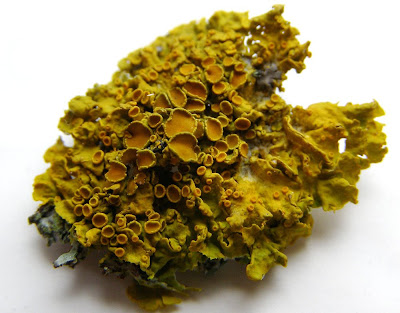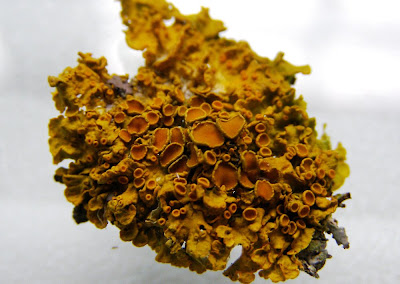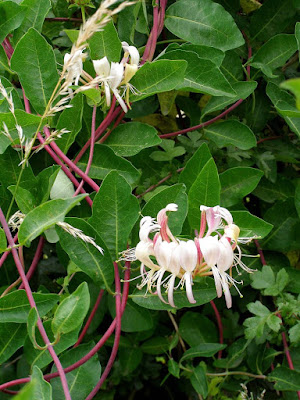A rather beautiful little butterfly today, seen flitting around the ragwort flowers, a Small Copper (Lycaena phlaeas).
These charming little butterflies are rather common in the British Isles. The caterpillars feed on the many different species of sorrel plants, while the adults are drawn to Ragworts and Thistle flowers among others. Seen here feeding with a Green-bottle and a Hover Fly.
Everywhere there are signs that what little Summer we have had, is coming to an end. No more so than in the hedgerows of the Nutbrook Trail, where the Blackberries (Rubus fruticosus) are starting to ripen. I have rarely seen so many Blackberries as are currently turning the hedgerows black.
Welcome to my blog. Don't expect anything too high-tech or flashy, this is simply a 'diary' to share some of my photos, thoughts and observations - with a particular bias towards the natural world and the countryside around my home.
Friday 31 July 2009
Thursday 30 July 2009
Storm
Arrived home from our walk this morning, just in time. Within two minutes of our getting home, the rain started - then the hail started - then the thunder started. Excellent timing!
On a lighter note, the sparrows and starlings are still attempting to eat us out of house and home by spending all the daylight hours chomping through the 'fat-balls'.
Hundreds of starlings descended on us a couple of days ago, ate almost everything in sight and then flew away again. I just love the upside down starling in this picture berating the one on the fat-ball.
It is amazing how many juvenile birds there are at the moment, it must have been a good year for them. This young starling had a less-than-happy look on it's face while waiting for the adult starling - and adult house sparrow to finish eating.
On a lighter note, the sparrows and starlings are still attempting to eat us out of house and home by spending all the daylight hours chomping through the 'fat-balls'.
Hundreds of starlings descended on us a couple of days ago, ate almost everything in sight and then flew away again. I just love the upside down starling in this picture berating the one on the fat-ball.
It is amazing how many juvenile birds there are at the moment, it must have been a good year for them. This young starling had a less-than-happy look on it's face while waiting for the adult starling - and adult house sparrow to finish eating.
Wednesday 29 July 2009
Rain!
I see this morning that the Met Office has had to revise it's forecast of a 'Barbecue Summer' and the promise of a warm and sunny August. Instead, it has now said we are likely to have an 'unsettled' August - a much used euphemism for piddling down. Well what do you know? Who would have thought that it would take hundreds of scientists, thousands of hours of meticulous work and millions of pounds of our money, to come up with that gem of knowledge? Has the Met Office lost the plot? Or is it just the lap-dog of the Government saying anything Gordon Brown wants it to say just to get people to spend their money at home this year instead of flying off on a much cheaper holiday abroad? Probably both!
Honestly, we would be better off with an old crone on the television, consulting a piece of seaweed and a dried up old pine cone to tell us the nightly forecast. Like so many sections of our modern society, the more sophisticated we become, the more technology we throw at things and the more money it costs, the worse off we become. I suppose now the Met Office have said August is going to be wet, we will be in for a month of drought and record temperatures - watch this space!
Tuesday 28 July 2009
Cabbage.
The family of plants known as Brassicas is a large and diverse one. Our ancient ancestors would have been extremely familiar with all of our native species as they were used as summer vegetables. Wild Cabbage (Brassica oleracea) was - and still is - eaten widely among the natives of Southern and Western Europe.
This specimen was photographed on the Great Orm, North Wales, ideal countryside for wild cabbages as they like the sea air and lime-rich soils. The Leaves form the main, edible part of the plant and it has been cultivated for many years as a garden vegetable from which the more familiar cabbages, Brussels Sprouts, etc. have been developed.
Another of our native Brassicas is the Hedge Mustard (Sisymbrium officinale).
A common British 'weed' it is widely seen on wasteland all over the place. The leaves of this plant have a strong 'mustard' flavour and have been used since ancient times as a condiment. It is also used by herbalists as an expectorant, stomach settler, diuretic and laxative as well as a general tonic. The seeds have also been used in parts of Europe, to make mustard paste.
This specimen was photographed on the Great Orm, North Wales, ideal countryside for wild cabbages as they like the sea air and lime-rich soils. The Leaves form the main, edible part of the plant and it has been cultivated for many years as a garden vegetable from which the more familiar cabbages, Brussels Sprouts, etc. have been developed.
Another of our native Brassicas is the Hedge Mustard (Sisymbrium officinale).
A common British 'weed' it is widely seen on wasteland all over the place. The leaves of this plant have a strong 'mustard' flavour and have been used since ancient times as a condiment. It is also used by herbalists as an expectorant, stomach settler, diuretic and laxative as well as a general tonic. The seeds have also been used in parts of Europe, to make mustard paste.
Monday 27 July 2009
Therapy!
Having taken a walk to Tesco this morning, I feel I am in need of therapy to get over the trauma.
Being the first Monday of the Summer Holidays, there were bastard children (and I use the word in it's most literal sense) everywhere, with fat bitch mothers in skin-tight leggings filling their trolleys with crisps, lager, burgers and 'pop'. The look of disgust which was etched on my face was only matched by the loathing which rose within me at the sight of a particularly vile specimen of womanhood with four hideous children around her and another on the way - the result of having her even more vile partner home, briefly from prison about six months ago. God help us, we have another six weeks of this! I have rarely been more grateful to get home.
On a lighter note (and having got that lot off my chest), here are today's pictures. Firstly, one of the signs that Autumn is on it's way. The appearance of berries starting to bejewel the trees. In this case, Rowan or Mountain Ash (Sorbus aucuparia).
The berries can be eaten, but are generally far too bitter. They are therefore made into a distinctive tasting jam, often used to accompany game dishes. The trees grow at higher altitude than any other native European tree, up to 6,000ft or more in some places. In England, it was once used as an aid to counter the effects of witchcraft (I wonder if it is effective against children....)
Lastly, not a native of this country, but from the Southern Hemisphere. From New Zealand, Polynesia, The Falklands and South America, comes the group of plants called Hebe.
Named after 'Hebe', the Greek Goddess of Youth (more blasted kids!), they are widely used for their ornamental qualities in gardens all over the world. There are about 90 different species of Hebe and they range in size from tiny shrubs just a few inches high, to small trees of 20ft or more. They are all very easy to strike from cuttings - this one being taken from a cutting off our neighbour's plant!
The berries can be eaten, but are generally far too bitter. They are therefore made into a distinctive tasting jam, often used to accompany game dishes. The trees grow at higher altitude than any other native European tree, up to 6,000ft or more in some places. In England, it was once used as an aid to counter the effects of witchcraft (I wonder if it is effective against children....)
Lastly, not a native of this country, but from the Southern Hemisphere. From New Zealand, Polynesia, The Falklands and South America, comes the group of plants called Hebe.
Named after 'Hebe', the Greek Goddess of Youth (more blasted kids!), they are widely used for their ornamental qualities in gardens all over the world. There are about 90 different species of Hebe and they range in size from tiny shrubs just a few inches high, to small trees of 20ft or more. They are all very easy to strike from cuttings - this one being taken from a cutting off our neighbour's plant!
Sunday 26 July 2009
Rained In
Not a nice morning, so no walk. Maybe this afternoon will brighten up - don't you just love optimism?
Anyway, here are some pictures from yesterday. Remember the Square Stalked St. John's Wort from 16th July? Well yesterday, we met one of it's close relatives, the Perforate St. John's Wort (Hypericum perforatum).
Very similar to the Square Stalked, you need to look very closely at the leaves of this one, to see the hundreds of minute perforations from which it gets it's name.
again, looking closely, this time at our own lawn, you can find several small patches of another 'Wort' this time, the name is far bigger than the plant, Procumbent Pearlwort (Sagina procumbens).
Looking rather 'mossy' amongst the grass in the lawn, it gets it's name from the small pearl-like seed capsules which appear above the leaves. Tiny and easily overlooked, it is a delicate looking plant, but it's looks belie it's nature. It is a surprisingly tough plant, able to stand drought and temporary submergence in water. Not growing taller than about 1/2" high, it forms a mat of green, looking, in places, better than the grass on our lawn!
Anyway, here are some pictures from yesterday. Remember the Square Stalked St. John's Wort from 16th July? Well yesterday, we met one of it's close relatives, the Perforate St. John's Wort (Hypericum perforatum).
Very similar to the Square Stalked, you need to look very closely at the leaves of this one, to see the hundreds of minute perforations from which it gets it's name.
again, looking closely, this time at our own lawn, you can find several small patches of another 'Wort' this time, the name is far bigger than the plant, Procumbent Pearlwort (Sagina procumbens).
Looking rather 'mossy' amongst the grass in the lawn, it gets it's name from the small pearl-like seed capsules which appear above the leaves. Tiny and easily overlooked, it is a delicate looking plant, but it's looks belie it's nature. It is a surprisingly tough plant, able to stand drought and temporary submergence in water. Not growing taller than about 1/2" high, it forms a mat of green, looking, in places, better than the grass on our lawn!
Saturday 25 July 2009
More Insects
More flying things today. To begin with, a gorgeous, bright blue little jewel found fluttering around the clover this morning. The Common Blue Butterfly (Polyommatus icarus).
Europe's most common blue butterfly and not always easy to distinguish from the many other 'Blues', it's favourite food plants are the pea family including clovers, trefoils, Medicks and Restharrows.
Next, a larger butterfly - the Painted Lady (Vanessa cardui).
This one was too preoccupied with sipping nectar from the Hemp Agrimony plants growing along the banks of the old Nutbrook Canal in Shipley Park to be bothered by me pointing my camera at it. With a wingspan reaching 3" it is about twice the size of the Common Blue.
A less conspicuous insect to finish today's posting. Indeed, you cannot even see it! Only the presence of small, red, blisters on the surface of the leaves of the Crack Willow trees give them away. We have all seen these 'galls' on willow leaves but did you know they contain the larva of the Willow Sawfly (Pontania proxima)?
The tiny grubs inside these galls will eventually break out and metamorphose into equally small, black wasp-like insects.
Europe's most common blue butterfly and not always easy to distinguish from the many other 'Blues', it's favourite food plants are the pea family including clovers, trefoils, Medicks and Restharrows.
Next, a larger butterfly - the Painted Lady (Vanessa cardui).
This one was too preoccupied with sipping nectar from the Hemp Agrimony plants growing along the banks of the old Nutbrook Canal in Shipley Park to be bothered by me pointing my camera at it. With a wingspan reaching 3" it is about twice the size of the Common Blue.
A less conspicuous insect to finish today's posting. Indeed, you cannot even see it! Only the presence of small, red, blisters on the surface of the leaves of the Crack Willow trees give them away. We have all seen these 'galls' on willow leaves but did you know they contain the larva of the Willow Sawfly (Pontania proxima)?
The tiny grubs inside these galls will eventually break out and metamorphose into equally small, black wasp-like insects.
Friday 24 July 2009
Carrots
Two members of the carrot family today. Some members of this family are highly poisonous (Water Hemlock for example), these two examples however are edible. Firstly the Wild Carrot (Daucus carota).
The cultivated and well-known vegetable carrot is a cultivar of a sub-species of this plant. The roots of the Wild Carrot are edible when young but quickly become woody and too tough to eat. Commonly seen growing in damp wasteland in Britain, it is easily confused with some of it's many relatives. True, Wild Carrots can be identified by the single red flower at the centre of the inflorescence of creamy-white flowers.
One of it's relatives is the Wild Angelica (Angelica sylvestris).
We all remember the small slivers of green angelica used to decorate cakes and puddings when we were kids - you just don't see it any more! Bright, fluorescent green slivers of angelica stems have fallen out of favour but the roots are sometimes used to flavour gin and are often used in Chartreuse.
The cultivated and well-known vegetable carrot is a cultivar of a sub-species of this plant. The roots of the Wild Carrot are edible when young but quickly become woody and too tough to eat. Commonly seen growing in damp wasteland in Britain, it is easily confused with some of it's many relatives. True, Wild Carrots can be identified by the single red flower at the centre of the inflorescence of creamy-white flowers.
One of it's relatives is the Wild Angelica (Angelica sylvestris).
We all remember the small slivers of green angelica used to decorate cakes and puddings when we were kids - you just don't see it any more! Bright, fluorescent green slivers of angelica stems have fallen out of favour but the roots are sometimes used to flavour gin and are often used in Chartreuse.
Tall and stately, standing over 6ft in some cases, the heads of flowers atop the stems have, from a distance, the look of small cauliflowers. Beautiful!
Thursday 23 July 2009
Liverwort
Strange, lower plant life in evidence this morning as we walked around the lake at Locko Park near Derby. Be specific, Common Liverwort (Marchantia polymorpha).
An oddity indeed as it clings to the surface of the soil using root-like structures known as rhizoids. The shiny 'leaves' are not actually leaves at all they are called thalli and can grow to several centimeters in length and up to 2cm wide, although these were much smaller. Mature specimens produce either male or female reproductive structures which rise from the middle of the thalli to form diminutive umbrella-like organs in the male plants, called antheridiophores, or things which look like minute palm trees in the case of the females, called archegoniophores. The plants in my pictures seem to be all females and have the appearance of a Lilliputian palm forest, about 1" high.
On a completely different note - and a much larger one, among the ducks and coots on the lake were several Greylag Geese (Anser anser).
Greylags are the largest of our native geese and are the ancestors of all our domesticated, 'farmyard' geese. Although a resident species in Britain their numbers are boosted during the winter by migrants from further north. It is thought there are some 3,200 pairs of wild Greylags in Britain, with at least 30,000 individual 'feral' birds. During the winter there may be as many as 92,000 wild birds feeding on grass, roots and spilled grain.
An oddity indeed as it clings to the surface of the soil using root-like structures known as rhizoids. The shiny 'leaves' are not actually leaves at all they are called thalli and can grow to several centimeters in length and up to 2cm wide, although these were much smaller. Mature specimens produce either male or female reproductive structures which rise from the middle of the thalli to form diminutive umbrella-like organs in the male plants, called antheridiophores, or things which look like minute palm trees in the case of the females, called archegoniophores. The plants in my pictures seem to be all females and have the appearance of a Lilliputian palm forest, about 1" high.
On a completely different note - and a much larger one, among the ducks and coots on the lake were several Greylag Geese (Anser anser).
Greylags are the largest of our native geese and are the ancestors of all our domesticated, 'farmyard' geese. Although a resident species in Britain their numbers are boosted during the winter by migrants from further north. It is thought there are some 3,200 pairs of wild Greylags in Britain, with at least 30,000 individual 'feral' birds. During the winter there may be as many as 92,000 wild birds feeding on grass, roots and spilled grain.
Wednesday 22 July 2009
Duck Domesticity
Two inquisitive little birds were attracted to Malcolm and I this morning, or at least to the bag Malcolm was carrying, in the hope that it contained bread! They were found waddling around Osborne's Pond as we were on our way back from breakfast at Tesco. Firstly a domesticated Muscovy Duck (Cairina moschata momelanotus).
Originally native of Mexico and Central America, they got the name 'Muscovy' from an association with Moscow, possibly from the trading of birds for food, with the 'Muscovite Company'. The name comes from around the late 16th century.
This little chap doesn't seem to have any Russian inclinations!
Alongside the Muscovy Duck was a smaller, but no less inquisitive little chap. A domestic (but not true) Aylesbury Duck (Anas platyrhynchos domesticus).
True Aylesburys should have a pink bill, but with much cross breeding, there are many different forms. This one was also particularly slim as they were originally bred for their meat and therefore rather more corpulent. But a more handsome duck, you couldn't find!
Originally native of Mexico and Central America, they got the name 'Muscovy' from an association with Moscow, possibly from the trading of birds for food, with the 'Muscovite Company'. The name comes from around the late 16th century.
This little chap doesn't seem to have any Russian inclinations!
Alongside the Muscovy Duck was a smaller, but no less inquisitive little chap. A domestic (but not true) Aylesbury Duck (Anas platyrhynchos domesticus).
True Aylesburys should have a pink bill, but with much cross breeding, there are many different forms. This one was also particularly slim as they were originally bred for their meat and therefore rather more corpulent. But a more handsome duck, you couldn't find!
Tuesday 21 July 2009
Up the Reds!
We saw, on 17th June, a 5-Spot Burnet Moth. Now, we go one stage better and find a 6-Spot Burnet! (Zygaena filipendulae).
Often difficult to separate from the 5-Spot Burnet as the two front spots are very close together and often fused together. It is however, an entirely separate species. A day-flying moth like the 5-Spot, it's spots are sometimes yellowish in colour or even black, which would make them even more difficult to distinguish against a black background! Again, like the 5-Spot, it pupates in a papery cocoon attached to grass stems.
Now bursting into flower is a lowly looking plant of the grassy path-sides, Red Bartsia (Odontites verna).
You need to look fairly closely to see the lovely little flowers of this plant. The whole plant can feel 'sticky' to the touch. It is rather common but easily ignored, but in times gone by, it was used as a cure for toothache. It is from this property where it gets it's scientific name, 'odons' meaning tooth in Greek.
Red Bartsia is a semi-parasitic plant on the roots of the grasses among which it grows. The flowers are great favourite of bees.
Often difficult to separate from the 5-Spot Burnet as the two front spots are very close together and often fused together. It is however, an entirely separate species. A day-flying moth like the 5-Spot, it's spots are sometimes yellowish in colour or even black, which would make them even more difficult to distinguish against a black background! Again, like the 5-Spot, it pupates in a papery cocoon attached to grass stems.
Now bursting into flower is a lowly looking plant of the grassy path-sides, Red Bartsia (Odontites verna).
You need to look fairly closely to see the lovely little flowers of this plant. The whole plant can feel 'sticky' to the touch. It is rather common but easily ignored, but in times gone by, it was used as a cure for toothache. It is from this property where it gets it's scientific name, 'odons' meaning tooth in Greek.
Red Bartsia is a semi-parasitic plant on the roots of the grasses among which it grows. The flowers are great favourite of bees.
Monday 20 July 2009
Fever!
Another plant today which has been used in antiquity for it's medicinal qualities. Familiar to gardeners, Feverfew (Tanacetum parthenium).
Slightly scented of citrus when crushed, it has been used to treat headaches, digestive problems and arthritic conditions for centuries. Prolonged use of Feverfew can lead to a dependence and subsequent withdrawal symptoms. The small, daisy-like flowers are quite ornamental, so the plant is commonly planted in gardens.
Finally for today and with apologies to Malcolm's mum, who doesn't like them, a snail. To be specific, a Brown-Lipped Snail (Cepaea nemoralis).
I mentioned the White Lipped Snail back in May and the Brown Lipped Snail is a close relative. The shell is very variable in colour but the distinguishing feature is the brown 'lip' around the shell opening.
Slightly scented of citrus when crushed, it has been used to treat headaches, digestive problems and arthritic conditions for centuries. Prolonged use of Feverfew can lead to a dependence and subsequent withdrawal symptoms. The small, daisy-like flowers are quite ornamental, so the plant is commonly planted in gardens.
Finally for today and with apologies to Malcolm's mum, who doesn't like them, a snail. To be specific, a Brown-Lipped Snail (Cepaea nemoralis).
I mentioned the White Lipped Snail back in May and the Brown Lipped Snail is a close relative. The shell is very variable in colour but the distinguishing feature is the brown 'lip' around the shell opening.
Sunday 19 July 2009
Insects
Two small insects today, one from our garden and the other from Shipley Park. To begin, a Ladybird. an enormous group of insects numbering about 5,000 species world wide. This particular little chap is a 7-Spot Ladybird (Coccinella septempunctata).
The most common of our native Ladybirds, living almost anywhere it can find food - aphids. The scientific name proves the common name, 7-Spot 'septem - punctata'. There are dozens of different Ladybirds in Britain including 2-Spot, 7-Spot, 10-Spot, Cream-Spot, Harlequin, Kidney-Spot, 11-Spot, 14-Spot, Water Ladybird, Orange Ladybird, etc, etc, etc. They are all voracious eaters of aphids and are therefore, a great help to gardeners.
Next, a butterfly species which is easy to overlook due to it's diminutive size and rather drab colouration. A Small Skipper (Thymelicus sylvestris).
This one was feeding on nectar from a red clover. The newly emerged caterpillars of this species, begin life by eating their egg case and then get to work on grasses. They especially like Yorkshire Fog, Timothy and Meadow Foxtail grass leaves. The adult butterfly, like most Skippers hold their fore wings at an angle to the hind wings rather than keeping them flat like other butterflies.
Next, a butterfly species which is easy to overlook due to it's diminutive size and rather drab colouration. A Small Skipper (Thymelicus sylvestris).
This one was feeding on nectar from a red clover. The newly emerged caterpillars of this species, begin life by eating their egg case and then get to work on grasses. They especially like Yorkshire Fog, Timothy and Meadow Foxtail grass leaves. The adult butterfly, like most Skippers hold their fore wings at an angle to the hind wings rather than keeping them flat like other butterflies.
Small Skippers are attracted (like many other insect species) to purple and red coloured flowers. Which explains why this one was so interested in the Red Clover!
Saturday 18 July 2009
What a Tease!
At this time of year, there is one plant which towers above almost all others, topped with hundreds of purple flowers. Teasel (Dipsacus fullonum).
All the botanical books will tell you that Teasels grow to around 6ft tall, but nobody seems to have told these which are growing around the old American Adventure Theme Park. Some of them are at least 8ft tall and a few seem much taller. They are just coming into flower and are attracting many different species of insects.
The prickly heads have, of course long been used in the textile industry as combs to raise the nap on fabrics, particularly wool. In recent years they have been replaced by metal combs, but some people still prefer Teasel combs. After the flowers, come the seeds and these are enjoyed by many species of bird especially Goldfinches, Siskins and any of the fine-billed finches.
A more lowly plant, yet distantly related to the Teasels are these strange, green-flowered annual. Pineappleweed (Matricaria discoidea).
Much smaller, growing only a few inches tall at the sides of paths and among the grasses of fields and wasteland. Despite the Pineapple shaped flower heads, it gets it's name from the smell of pineapple which it produces when crushed. The plant has been used as a salad ingredient, but the leaves can be rather bitter. They can be used to make a herbal tea and when rubbed onto the skin, they are supposed to repel insects.
All the botanical books will tell you that Teasels grow to around 6ft tall, but nobody seems to have told these which are growing around the old American Adventure Theme Park. Some of them are at least 8ft tall and a few seem much taller. They are just coming into flower and are attracting many different species of insects.
The prickly heads have, of course long been used in the textile industry as combs to raise the nap on fabrics, particularly wool. In recent years they have been replaced by metal combs, but some people still prefer Teasel combs. After the flowers, come the seeds and these are enjoyed by many species of bird especially Goldfinches, Siskins and any of the fine-billed finches.
A more lowly plant, yet distantly related to the Teasels are these strange, green-flowered annual. Pineappleweed (Matricaria discoidea).
Much smaller, growing only a few inches tall at the sides of paths and among the grasses of fields and wasteland. Despite the Pineapple shaped flower heads, it gets it's name from the smell of pineapple which it produces when crushed. The plant has been used as a salad ingredient, but the leaves can be rather bitter. They can be used to make a herbal tea and when rubbed onto the skin, they are supposed to repel insects.
Friday 17 July 2009
Poison
Two, poisonous things for today's post. Firstly a weed which is found growing in abundance on almost every bit of wasteland in Britain as well as the cracks in paths and car parks. Common Ragwort (Senecio jacobaea or Jacobaea vulgaris).
This plant has many alternative names, most of which relate to the poisonous properties of the plant including Stinking Nanny/Ninny/Willy, Staggerwort, Dog Standard, Cankerwort, Stammerwort and even Mare's Fart! The latter refers to the nasty smell of the leaves.
It contains a cocktail of poisonous chemicals detailed in the World Health Organisation's report EHC 80.
Despite the unpalatable nature of this plant, one small creature can be found every Summer eating happily on it's leaves and stems. We found one of these creatures this morning, eating for all it was worth. The caterpillar of the Cinnabar Moth (Tyria jacobaeae). The scientific name of this moth reflects the fact that it feeds on the Ragwort.
The caterpillars absorb the toxins from the Ragwort plants and thus become poisonous themselves. The bright yellow and black colouration advertises the fact to any other animal which might otherwise look upon it as a meal - a tactic adopted by many animal species throughout the world.
This plant has many alternative names, most of which relate to the poisonous properties of the plant including Stinking Nanny/Ninny/Willy, Staggerwort, Dog Standard, Cankerwort, Stammerwort and even Mare's Fart! The latter refers to the nasty smell of the leaves.
It contains a cocktail of poisonous chemicals detailed in the World Health Organisation's report EHC 80.
Despite the unpalatable nature of this plant, one small creature can be found every Summer eating happily on it's leaves and stems. We found one of these creatures this morning, eating for all it was worth. The caterpillar of the Cinnabar Moth (Tyria jacobaeae). The scientific name of this moth reflects the fact that it feeds on the Ragwort.
The caterpillars absorb the toxins from the Ragwort plants and thus become poisonous themselves. The bright yellow and black colouration advertises the fact to any other animal which might otherwise look upon it as a meal - a tactic adopted by many animal species throughout the world.
Thursday 16 July 2009
Colourful
Colours abound in the summer hedgerows. I included a picture of Rosebay Willowherb a few days ago and they are indeed colourful plants, but take a closer look at the individual flowers of this stately perennial.
The down-curved stamens and 4-lobed stigma drooping from the centre of each flower show off the four spoon-shaped petals and the four thin, darker pink sepals.
You might know the name of the next flower from the side of a skin preparation in the medicine cabinet! Evening Primrose (Oenothera biennis), is a member of the same genus as the Willowherbs and is often grown in gardens for it's large, bright yellow flowers.
Evening Primroses are an introduced species from North America and is now fairly widespread across Britain. Standing about 3ft tall, they are like golden suns among the grasses and brambles.
Lastly for today, another yellow flower, this time much smaller. Square-stalked St.John's-Wort (Hypericum terapterum). Hypericums are also well-known as garden shrubs (my mother has a large Hypericum 'Hidcot' in her garden turned into high-rise accommodation by the sparrows).
This wild Hypericum was growing in the small, water-filled ditch running beside the path on our walk this morning. St.John's-Wort is also often seen as an ingredient in the medicine cabinet.
The down-curved stamens and 4-lobed stigma drooping from the centre of each flower show off the four spoon-shaped petals and the four thin, darker pink sepals.
You might know the name of the next flower from the side of a skin preparation in the medicine cabinet! Evening Primrose (Oenothera biennis), is a member of the same genus as the Willowherbs and is often grown in gardens for it's large, bright yellow flowers.
Evening Primroses are an introduced species from North America and is now fairly widespread across Britain. Standing about 3ft tall, they are like golden suns among the grasses and brambles.
Lastly for today, another yellow flower, this time much smaller. Square-stalked St.John's-Wort (Hypericum terapterum). Hypericums are also well-known as garden shrubs (my mother has a large Hypericum 'Hidcot' in her garden turned into high-rise accommodation by the sparrows).
This wild Hypericum was growing in the small, water-filled ditch running beside the path on our walk this morning. St.John's-Wort is also often seen as an ingredient in the medicine cabinet.
Wednesday 15 July 2009
Weed!
A commonly seen 'weed' in everyone's garden and in every wayside location, is the Greater Plantain (Plantago major).
It is well known for it's long-rooted tenacity and ability to grow seemingly anywhere. It is less well-known for it's use as field dressing by soldiers on the battlefield. It is called 'Englishman's Foot' by Native American Indians because it was seen to grow wherever a 'white man walked'.
The leaves are edible but they are fibrous, 'stringy' and tough and very bitter.
The sinews in the leaves can be used to make short lengths of string as they are very strong and malleable when wet. The leaves can also be applied to insect bites and stings to help alleviate the symptoms.
It is well known for it's long-rooted tenacity and ability to grow seemingly anywhere. It is less well-known for it's use as field dressing by soldiers on the battlefield. It is called 'Englishman's Foot' by Native American Indians because it was seen to grow wherever a 'white man walked'.
The leaves are edible but they are fibrous, 'stringy' and tough and very bitter.
The sinews in the leaves can be used to make short lengths of string as they are very strong and malleable when wet. The leaves can also be applied to insect bites and stings to help alleviate the symptoms.
Tuesday 14 July 2009
Lichen
Something a little different today. Lichens are composite organisms consisting of a symbiotic relationship between a fungus and either an algae or bacteria. Lichens grow in some of the most inhospitable parts of the world and under extreme circumstances. This particular one was growing on our roof until dislodged, possibly by a Magpie. It's called Xanthoria parietina.
One of the so-called 'leafy' lichens, it was used in times gone by as a treatment for jaundice, because of it's colour - without success, it must be said!
The leathery surface of this lichen is formed by fungal hyphae (the 'root-like' structures of a fungus). This skin is essential to limit water loss and so prevent dehydration in the arid conditions of walls, roofs, etc.
One of the so-called 'leafy' lichens, it was used in times gone by as a treatment for jaundice, because of it's colour - without success, it must be said!
The leathery surface of this lichen is formed by fungal hyphae (the 'root-like' structures of a fungus). This skin is essential to limit water loss and so prevent dehydration in the arid conditions of walls, roofs, etc.
Sunday 12 July 2009
Hedgerow
A couple of familiar hedgerow plants today, though not usually seen in the wild, but more often in our gardens. The first is, perhaps, the archetypal hedgerow shrub, seen in many gardens and used as a boundary plant, Privet (Ligustrum ovalifolium)
In this case a variety often called Japanese Privet which is more reliably evergreen. The flowers are not very often seen when grown in gardens as they tend to be clipped away to keep the shrub in check, but they are creamy white and very fragrant so it seems a shame to trim them off.
Next, another garden favourite and a quintessentially 'cottage' garden plant. The Honeysuckle (Lonicera periclymenum).
Also known as Woodbine - after it's habit of entwining itself around woodland trees and shrubs, not after the cigarette! Again, the flowers of this plant are well known for their fragrance. The fragrance is especially strong in the evenings and after dark when the flowers attract moths to pollinate them. Long-tongued bees take over the task during the daylight hours. The flowers are followed in the Autumn by red berries.
In this case a variety often called Japanese Privet which is more reliably evergreen. The flowers are not very often seen when grown in gardens as they tend to be clipped away to keep the shrub in check, but they are creamy white and very fragrant so it seems a shame to trim them off.
Next, another garden favourite and a quintessentially 'cottage' garden plant. The Honeysuckle (Lonicera periclymenum).
Also known as Woodbine - after it's habit of entwining itself around woodland trees and shrubs, not after the cigarette! Again, the flowers of this plant are well known for their fragrance. The fragrance is especially strong in the evenings and after dark when the flowers attract moths to pollinate them. Long-tongued bees take over the task during the daylight hours. The flowers are followed in the Autumn by red berries.
Subscribe to:
Posts (Atom)

